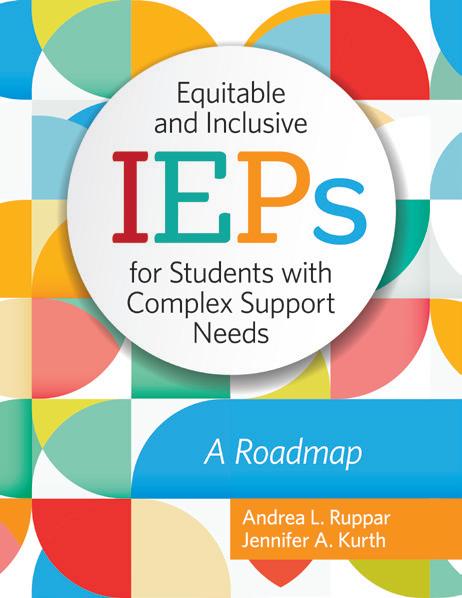


Teaming
CONTENT




Teaming
CONTENT
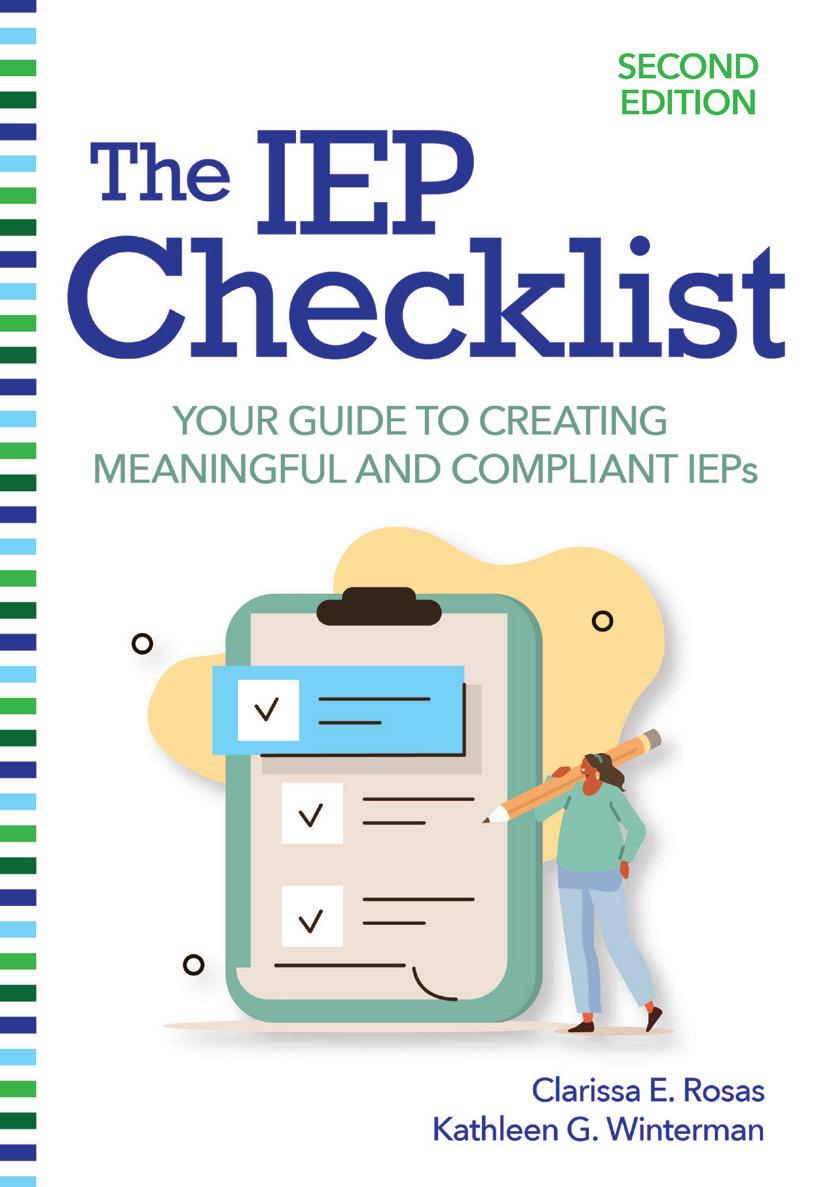

 By Clarissa E. Rosas, Ph.D. (Mount Saint Joseph University), & Kath leen G. Winterman, Ed.D. (Xavier University), with invited contributors
By Clarissa E. Rosas, Ph.D. (Mount Saint Joseph University), & Kath leen G. Winterman, Ed.D. (Xavier University), with invited contributors
How can special education teams create effective IEPs that improve student outcomes and meet legal requirements? Find practical answers in the second edition of this textbook, updated with new chapters on key topics, online resources, and practical features that make this edition perfect for either preservice courses or in-service teamwork.
Future educators will get a thorough introduction to IEPs and a comprehensive framework for IEP development, featuring a unique, in-depth checklist that breaks the whole process into small, manage able steps. Your students will learn how to collaborate during an IEP meeting, assess a student’s present levels of performance, develop meaningful IEP goals and objectives for all students (including cultur ally diverse learners), choose accommodations, use progress monitor ing data to make instructional decisions, and support transitions from school to adulthood. Practical content throughout the book—includ ing planning tips, vivid examples, reflection questions, and practice activities—gives your students the knowledge and experience they’ll need to create legally compliant IEPs and put them into action.
WHAT’S NEW:

• New chapters on making IEP practices culturally responsive, de signing behavior intervention plans, and supporting students with disabilities in private and parochial schools
Student-friendly features such as chapter objectives, reflection questions, a glossary, and challenge scenarios to encourage critical thinking skills
Updated activities that help guide and improve IEP development
online resources, including English- and Spanish-language
surveys
critical new research and practices
field
PRACTICAL TOOLS: IEP meeting preparation
that required elements
each element,
template
making
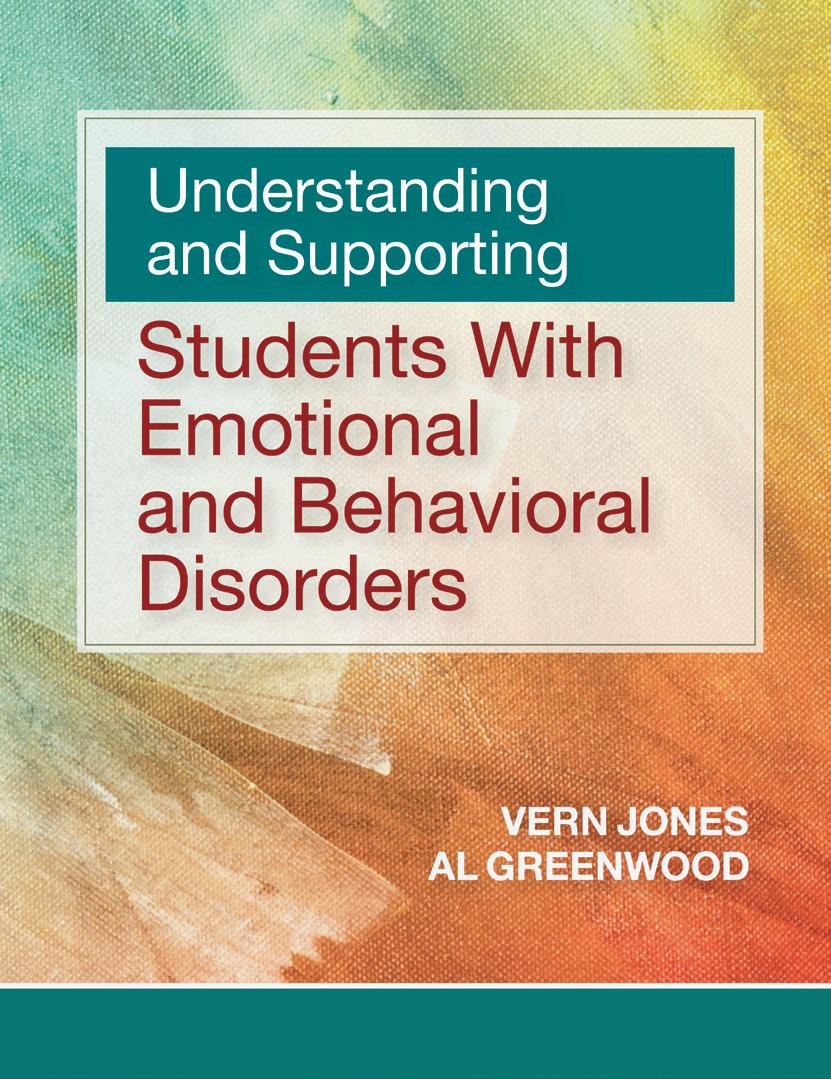 By Vern Jones, Ph.D. (Emeritus Professor of Education, Lewis & Clark College), & Al (Skip) Greenwood, Ph.D. (licensed clinical psychologist)
By Vern Jones, Ph.D. (Emeritus Professor of Education, Lewis & Clark College), & Al (Skip) Greenwood, Ph.D. (licensed clinical psychologist)
Students who experience serious emotional and/or behavioral dis orders (EBD) are at risk for a wide range of negative outcomes, from limited academic progress to problems with employment and commu nity life after they leave school. Positive educational experiences can help, and this textbook fully prepares educators, school psychologists, and administrators to create supportive K–12 learning environments that help students with EBD thrive.
This comprehensive text gives future professionals a deep under standing of the key issues associated with EBD and practical, traumainformed approaches for working with these students in a variety of settings, from general education classrooms to specialized interven tion programs. Your students will discover how to:
• Recognize key factors that influence each student’s behavior, such as developmental history, personal characteristics, skill sets, and social perceptions
• Deliver meaningful, engaging instruction within safe and supportive learning environments
• Involve students in creating behavioral standards that support en gagement in instruction
• Develop effective behavior support plans that include assessment and intervention
• Respond with proven strategies when students fail to follow estab lished behavior standards
• Engage students in problem solving and conflict resolution
• Implement social–emotional learning strategies that help break down obstacles to school success
PRACTICAL FEATURES: Chapter outcomes, summaries, reflection activities, forms, sample lessons, checklists, and case studies ensure comprehension and help your students successfully implement the concepts and methods. Also included is a complete package of online companion materials for faculty, featuring PowerPoint slides, a test bank, and sample syllabi.
1. Key Concepts and Assumptions Related to Effec tive Support For Students With Emotional And Behavioral Disorders
2. Developing A Foundational Understanding of Emotional and Behavioral Disorders
3. Creating Supportive Adult–Student and Peer Rela tionships
4. Developing Behavior Standards and Increasing Students’ Motivation to Learn


5. Responding Effectively to Disruptive Behavior
6. Developing Individualized Behavior Support Plans: Planning for Student Success

7. Social-Emotional Learning Methods for Support ing Student Success
8. Developing an Effective Program for Students Identified as EBD
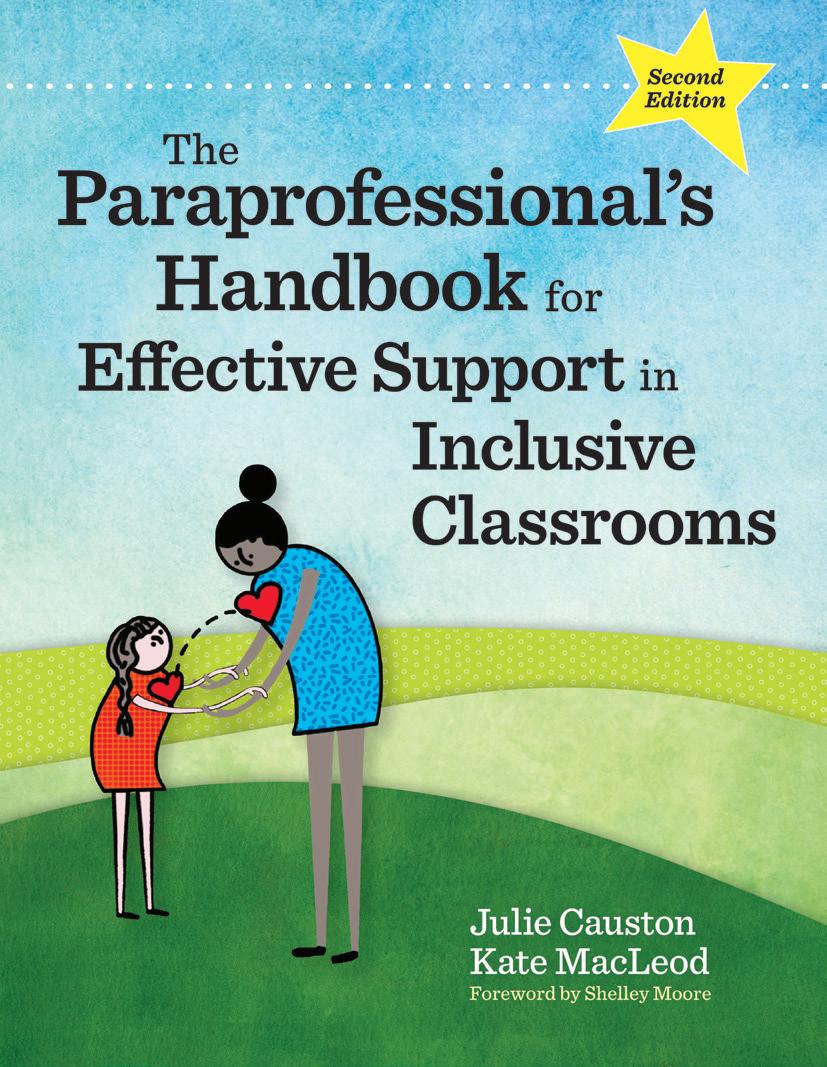
By Julie Causton, Ph.D. (founder and CEO of Inclusive Schooling, formerly of Syracuse University), & Kate MacLeod, Ph.D. (University of Maine at Farmington, founder and consultant at Inclusive Schooling)
“Provides foundational orientation and training con tent for paraprofessionals. Its accessible style, focus on inclusive contexts, and practical applications should make it a go-to resource.”

—Michael Giangreco, Ph.D., University of Vermont, Center on Disability & Community Inclusion
What does a great paraprofessional need to know and do? Your students will find real-world answers from two experts in the second edition of this bestselling guidebook. Passionate inclusion advocates
Julie Causton and Kate MacLeod bring future praprofessionals a su premely practical guide to surviving and thriving as an integral part of a school’s inclusive team.

Your students will get immediately applicable strategies for mastering every facet of their complex role: collaborating with other team mem bers, selecting accommodations and modifications, facilitating peer connections, fading their support, and much more. And they’ll have a treasure trove of tools—including activities, learning checks, reproduc ible templates, FAQs, and short to-do lists—to help them reflect on their practice and strengthen their daily work once they’re on the job.
An essential-hands-on guide for tomorrow’s paraprofessionals, this empowering book takes the guesswork out of this critical classroom role and prepares future professionals to help students with disabili ties reach their full potential.

chapter
Respectful Support for Developing Student
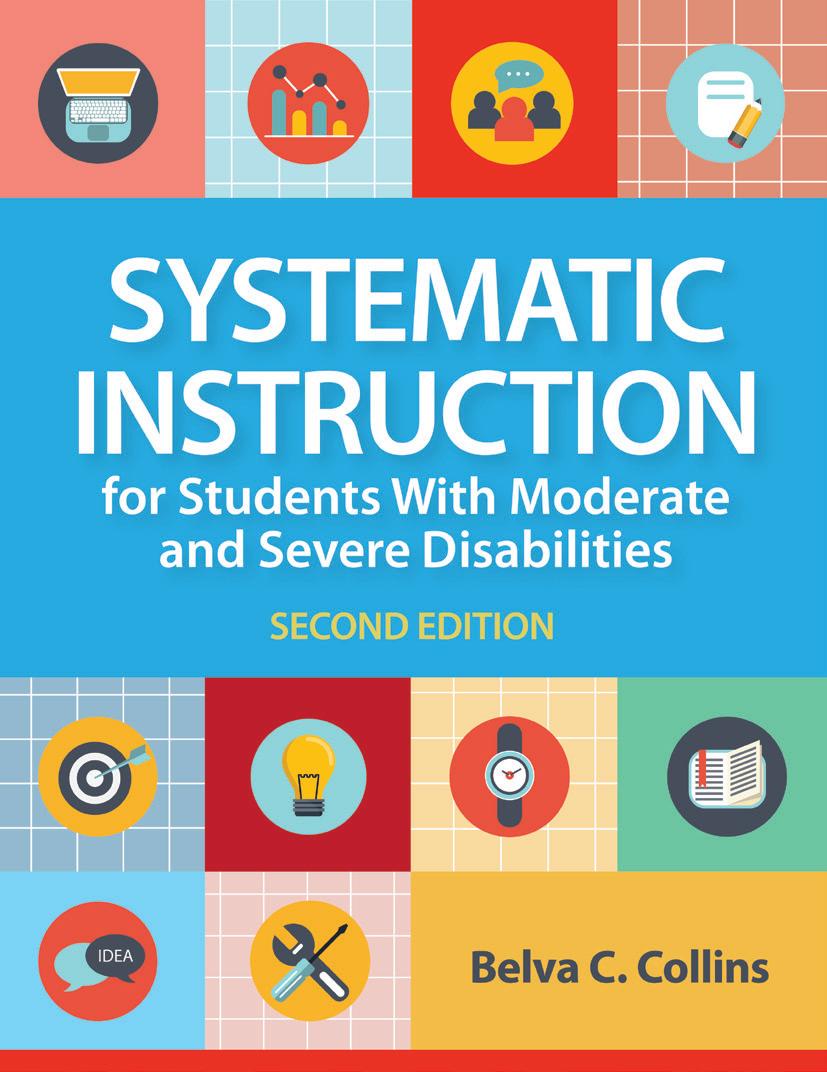
To improve outcomes for students with moderate and severe disabilities, future K–12 educators need to understand the why and how of good instructional practices. They’ll find comprehensive guidance in the second edition of this bestselling text on systematic instruction, a highly effective teaching approach rooted in applied behavior analysis (ABA).
Fully revised and updated with timely topics and new sample lesson plans, this reader-friendly textbook prepares teachers to use dynamic, adaptable systematic instruction strategies to teach core content that is age-appropriate, meaningful, and relevant to students’ lives. Tomorrow’s teachers will discover evidence-based methods that help them with every step of systematic instruction, from collecting accurate screening and baseline data to supporting students as they generalize new skills to other settings. And faculty members will get a complete package of online instructor materials they can use in their courses, including test banks, PowerPoint slides, flowcharts for instructional procedures, and blank data sheets.
• Revised and updated chapters throughout, with a wealth of practical strategies
• A full package of online faculty materials
• 14 new sample lesson plans, including learning objectives, instructional contexts, materials needed, teaching procedures, data collection and maintenance guidelines, and lesson extensions and variations
• Insightful commentary from special educators in each chapter
• More on working with parents and caregivers
• Guidance in each chapter about adapting systematic instruction methods for distance learning
• New chapter on making instructional decisions and exercising leadership
• Explicit guidance on combining functional core content with standards-based instruction
• More on inclusion and culturally responsive practices
• Up-to-date research on systematic instruction
Using Systematic Instruction When Teaching Standards in Inclusive Classrooms
Using Technology with Systematic Instruction
Involving Others in Implementing Systematic Instruction
Developing Data Sheets and Collecting Baseline Data
Using Effective Practices to Teach Learners with Moderate and Severe Disabilities
Applying the Principles of ABA to Teach Learners with Moderate and Severe Disabilities
Using Response Prompting Strategies: Graduated Guidance, Most-to-Least Prompting, and System of Least Prompts
Using Response Prompting Strategies: Time Delay and Simultaneous Prompting Procedures

Increasing the Efficiency of Instruction
Facilitating Maintenance and Generalization

Making Instructional Decisions and Exercising Leadership

“The 1970s brought about change in the way American society treated human beings who were viewed as ‘deficient’ because of the difference in their physical or intellectual abili ties . . . in his storytelling, [Shane] allows us to remember the people who endured those experiences. When educators think inclusion in schools is not important, they need to read this book to understand WHY it is a must. ”
—Carol Quirk, Ed.D., Chief Executive Officer, Maryland Coalition for Inclusive Education, Inc. (MCIE)



For future educators and other practitioners getting ready to work with people who have disabilities, learning the history of our attitudes and actions regarding disability is a vital part of professional preparation. That’s why this important and illuminating new book should be part of every recommended reading list for higher education courses on disability.
The year is 1969, and fresh-out-of-college smart-aleck Howard Shane has just landed his first teaching job—at Belchertown State School, a bleak institution where people with disabilities endure endless days of silence, tedium, and neglect.
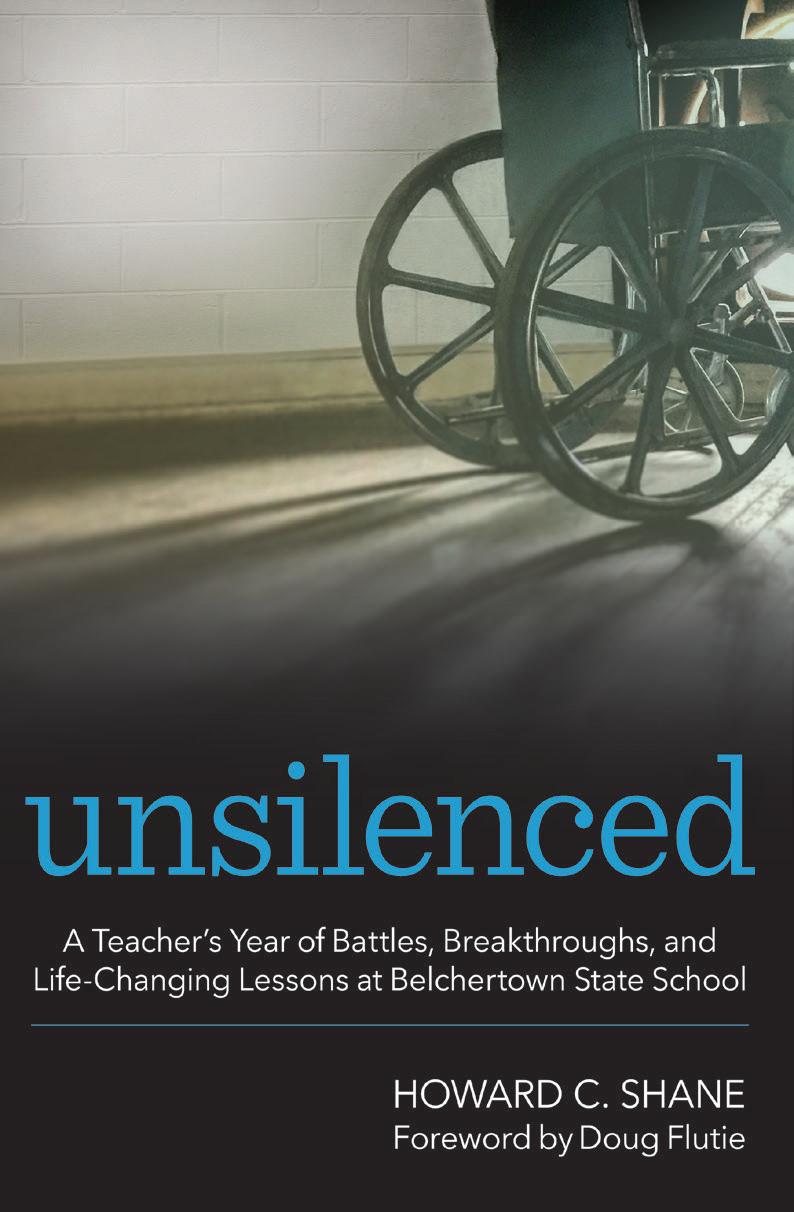
Howard is stunned by the conditions at Belchertown and the challenges of his new job, but as he gets to know his diverse, endearing, and intelligent students, he becomes consumed with a mission: to unlock their communication skills and help them reach their full potential. Pitting his youthful idealism and passion against the rigidity of a rulebound administrator, Howard battles his way to small joys and victories with his students—and, along the way, learns just as much as he teaches.
A stirring and spellbinding memoir from internationally renowned AAC expert Howard Shane (Boston Children’s Hospital, Harvard Medical School), Unsilenced is a candid look at a pivotal era in disability history and a deeply personal account of how all human beings can flourish when we care for each other and fight for change. Eye-opening and unforgettable, this book is essential supplementary reading for a wide range of future professionals as they prepare to work with children and adults with disabilities.
US$29.95 | Stock #: 55156 | 2022 | 264 pages + 8-page photo insert | paperback | ISBN 978-1-68125515-6
You can request exam/desk copies of up to two books that are relevant to your course needs. If you see a book in this catalog that you’re interested in previewing, please look it up on www.brookespublishing.com, click the Request Exam Copy button found on the book’s page, and complete the request form. (All requested information must be supplied before we can process your order.)
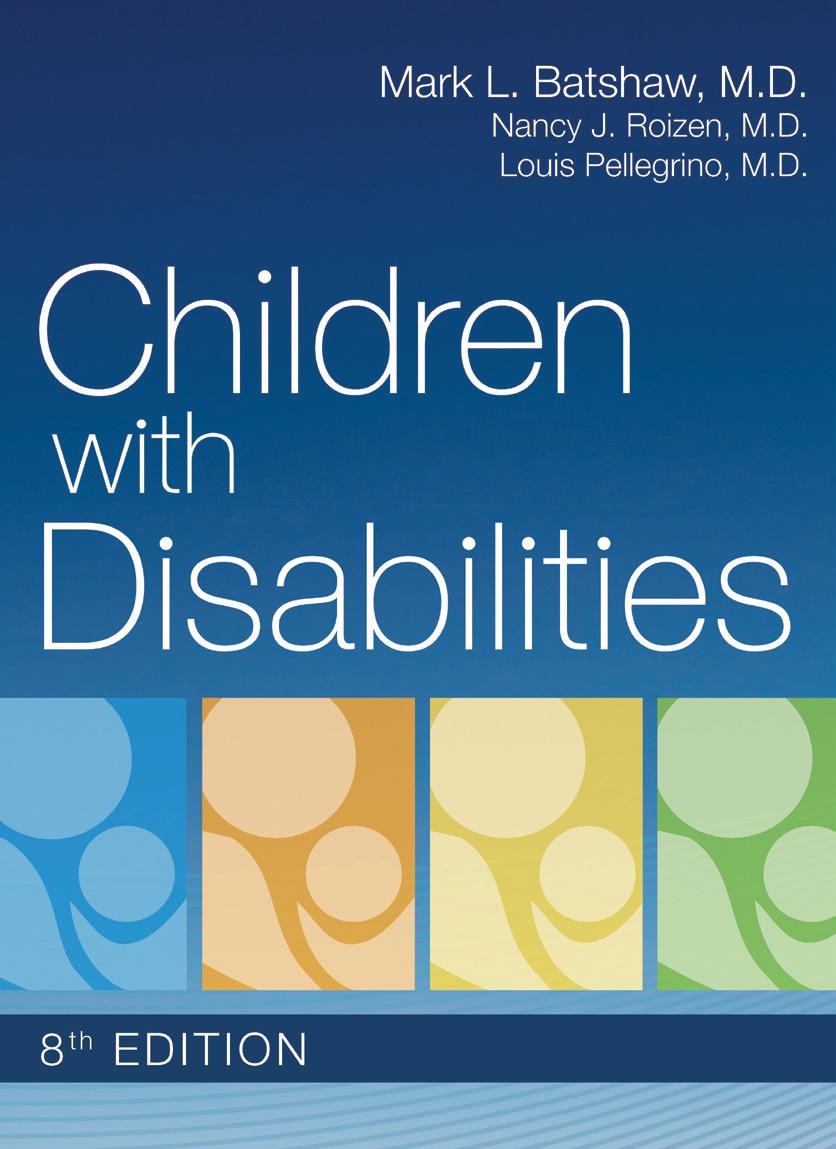
Edited by Mark L. Batshaw, M.D. (Children’s National Medical Center, George Washington University), Nancy J. Roizen, M.D. (University Hospital’s Rainbow Babies and Children’s Hospital in Cleveland), & Louis Pellegrino, M.D. (SUNY Upstate Medical University)
Trusted for four decades by university faculty and relied on by thousands of professionals from diverse fields, Children with Disabilities is the gold-standard text on working effectively with children and families. The NEW edition of this authoritative resource is an unparalleled compendium of information about developmental, clinical, family, education, and intervention issues, from birth through adolescence. Every chapter has been meticulously peer-reviewed, and content has been updated throughout to reflect important new research and developments in diverse fields.

Expanded focus on interdisciplinary care, including guidance on how professionals from different fields can effectively collaborate
New chapters on key topics: sleep disorders, assessment of physical disabilities, the senses, rehabilitative services, interdisciplinary care, the role of medication, and the effect of health care disparities on child outcomes

New Evidence-Based Practice boxes throughout the text, for easy review of recent studies and recommended practices
Updated nomenclature based on new developments in the field and recommendations from respected

NUMERACY IN MIDDLE SCHOOL
By Leanne R. Ketterlin-Geller, Ph.D. (Southern Methodist University), Sarah R. Powell, Ph.D. (The University of Texas at Austin), David J. Chard, Ph.D. (Boston University), & Lindsey Perry, Ph.D. (Southern Methodist University)
Get future educators ready to make all middle schoolers confident and competent mathematicians with this accessible guide to teaching math to every learner in Grades 6-8. Focused on knocking down roadblocks to learning, this reader-friendly textbook shows teachers how to use multitiered systems of support (MTSS)—a powerful, widely adopted framework for meeting each student’s individual needs. Preservice educators will learn how to deliver high-quality, evidence-based math instruction; combine instruction with meaningful assessment; and provide just-right supports that help students conquer their specific math struggles.
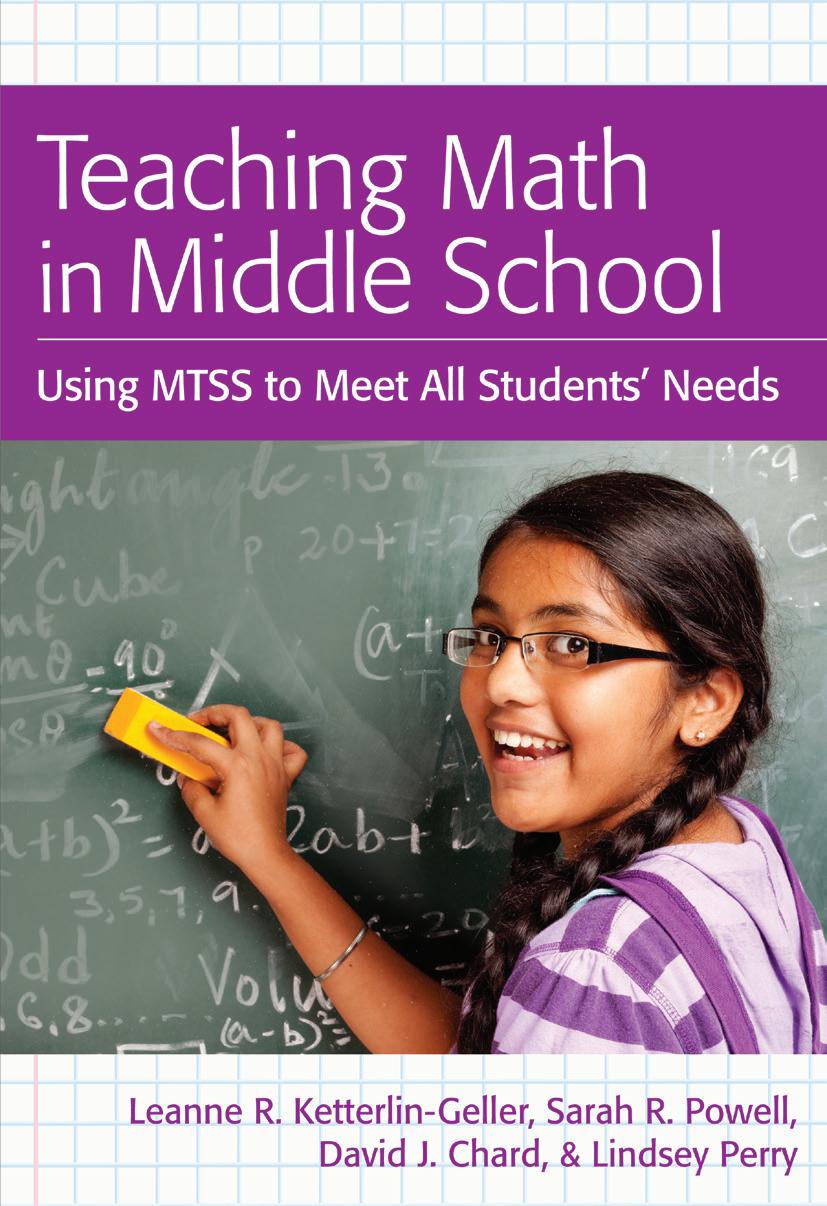
An essential resource for teachers in training, this book offers the indepth knowledge and practical tools tomorrow’s educators need to support every student’s success in middle school math.


• Implement MTSS to benefit all students. Develop and use tiered supports across a whole school, promote collaboration between general and special educators, and troubleshoot an MTSS.
• Build foundational numeracy skills. Help students strengthen the three pillars of numeracy that build algebraic proficiency.
• Design and deliver effective math instruction. Use today’s recommended practices to teach all students, and develop Tier 2 and Tier 3 interventions that really help struggling learners.
• Choose and use effective supports. Distinguish between differentiation, accommodation, and modification, and learn when and how to use them.
• Use data to make decisions. Learn how to select and use screeners, diagnostic assessments, progress monitoring tools, and summative assessments—and use results to shape instruction.

MATERIALS: More than a dozen downloadable forms
teachers plan for MTSS and implement what they learned from the book, vignettes and sample problems model best practices,
real-life educators brim with valuable advice on
education.
By David H. Allsopp, Ph.D. (University of South Florida), Lou Ann H. Lovin, Ph.D. (James Madison University), & Sarah van Ingen, Ph.D. (University of South Florida)
Unlock math concepts for struggling learners with the expanded new edition of this bestselling text! Filled with invaluable tips, tools, and research-based strategies for Grades K–12, this comprehensive resource fully prepares future teachers to demystify math for a wide range of learners, including students with learning disabilities, ADHD, and mild cognitive disabilities.
DISCOVER HOW TO:
• Uncover the barriers to students’ math success and effectively break them down
• Teach the big ideas of math and link them to Common Core State Standards
• Plan and implement student-centered instruction that responds to each learner’s individual needs
• Apply teaching practices for struggling learners within a multitiered system of supports (MTSS)
• Align instructional approaches with NCTM Teaching Practices
• Select assessment practices appropriate for struggling students
PRACTICAL MATERIALS: More than a dozen Take Action activities, reproducible planning forms (available in the book and online), and an in-depth case study that walks readers through the Teaching Mathematics Meaningfully process.
IN THIS EDITION:
• An updated framework that makes the Teaching Mathematics Meaningfully process clearer and easier

• A clear and convenient summary of each step in the process
• A framework now aligned with Common Core State Standards
• Incorporation of the most current research and recommended practices
• Special focus on response to intervention/multi-tiered systems
• Take Action Activities for application of the concepts and framework
• More information on learning trajectories in mathematics
1. Critical Components of Meaningful and Effective Mathematics Instruction for Students with Disabilities and Other Struggling Learners
I. IDENTIFY AND UNDERSTAND THE MATHEMATICS



2. The Big Ideas in Mathematics and Why They Are Important
3. Children’s Mathematics: Learning Trajectories
II. LEARNING THE NEEDS OF YOUR STUDENTS AND THE IMPORTANCE OF CONTINUOUS ASSESSMENT
4. Barriers to Mathematical Success for Students with Disabilities and Other Struggling Learners
5. Math Assessment and Struggling Learners
III. PLAN AND IMPLEMENT RESPONSIVE INSTRUCTION
6. Making Flexible Instructional Decisions: A Continu um of Instructional Choices for Struggling Learners
7. Essential Instructional Approaches for Struggling Learners in Mathematics
8. Changing Expectations for Struggling Learners: Integrating the Essential Instructional Approaches with the NCTM Mathematics Teaching Practices
9. Mathematics MTSS/RTI and Research on Mathematics Instruction for Struggling Learners
10. How to Intensify Assessment and Essential Instructional Approaches Within MTSS/RTI
11. Intensifying Math Instruction Across Tiers within MTSS: Evaluating System-Wide Use of MTSS
IV. BRINGING IT ALL TOGETHER
12. The Teaching Mathematics Meaningfully Process
APPENDICES
A. Take Action Activities
ARC Assessment Planning Form
Peer-Tutoring Activity
Using a Think-Aloud
Case Study
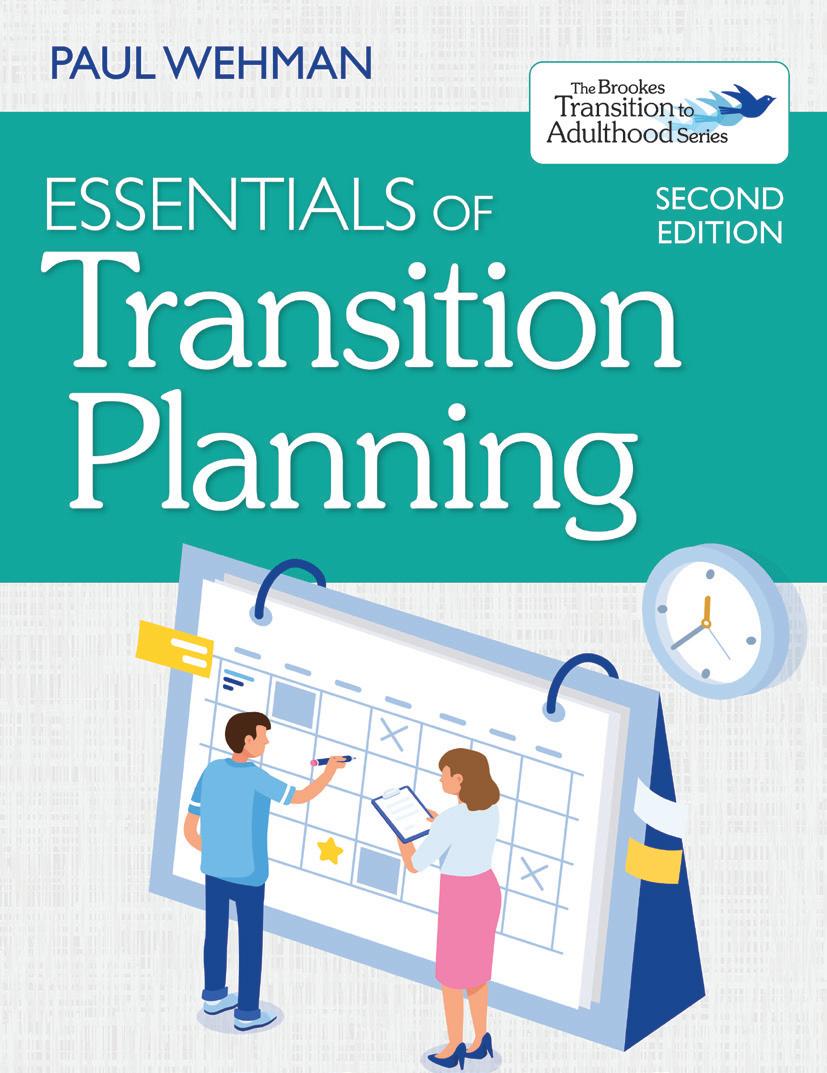 By Paul Wehman, Ph.D. (Virginia Commonwealth University), with invited contributors
By Paul Wehman, Ph.D. (Virginia Commonwealth University), with invited contributors

“An exceptional resource that includes valuable and practical transition planning strategies, along with anecdotes that clearly illustrate their application.”
—Richard Luecking, Ed.D., University of Maryland
Introduction to Transition Planning
Individual and Community Transition Planning: Focus on Inclusion
Developing the Transition Curriculum
Planning for the Future: One Student at a Time
Writing the Transition Individualized Education Program
Implementing the Transition Individualized Educa tion Program
Understanding the Different Pathways to Competi tive Employment from School
Customized Employment
Funding Transition Programs: Toward a Seamless Transition from School into Adulthood
All the essentials of transition planning are at your students’ fingertips in the second edition of this popular textbook, a one-stop guide to helping young people live fulfilling adult lives beyond the classroom. Renowned expert Paul Wehman and a select group of contributors introduce future professionals to all the fundamentals of transition planning, offering fast facts, vivid examples, realistic case studies, and checklists and tools for putting a plan into action.
Expanded and updated with the very latest on new legislation, funding sources, and other timely topics, this reader-friendly resource will help current and future professionals prepare young people to lead successful, self-determined adult lives in their communities.
• Guidance on the Workforce Innovation and Opportunity Act (WIOA) and its implications for transition and employment

• All-new chapter on customized employment
In-depth coverage of funding sources available today due to new legislation
• More emphasis on involving students and families in transition planning as early as middle school
New information on working with minority populations
Cutting-edge case studies that reflect the current state of transition services
More on employment goals and postsecondary education goals
New evidence-based practices for students with complex support needs
Downloadable sample syllabi
PRACTICAL MATERIALS: Transition Planning Checklist
A Checklist
Inclusive Schooling • Career and Vocational Transition Worksheet
Education Transition Worksheet
Social Competencies

Dos and Don’ts of Transition IEP Implementation
and more
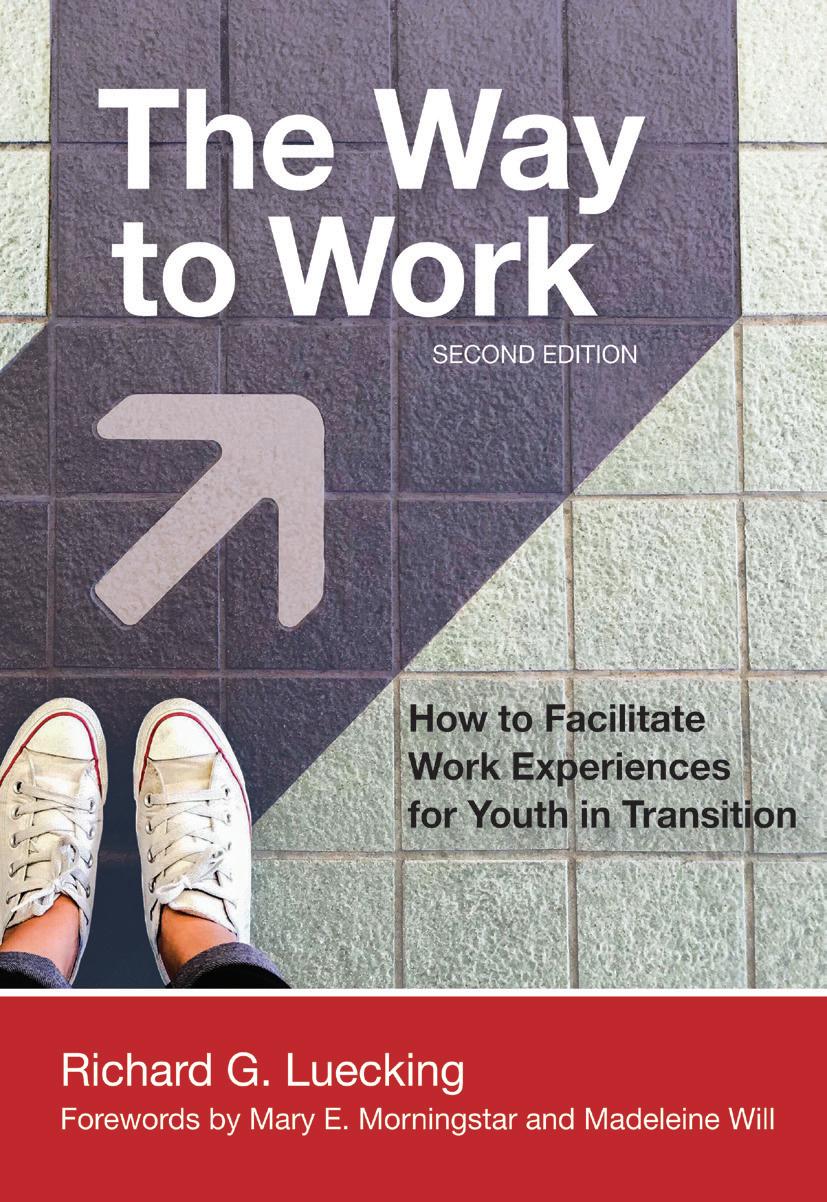 By Richard G. Luecking, Ed.D. (University of Maryland, College Park), with invited contributors
By Richard G. Luecking, Ed.D. (University of Maryland, College Park), with invited contributors
“An excellent and comprehensive overview of history, legislation, and practical information related to the employment of persons with disabilities.”
—Gary Greene, Ph.D., Professor Emeritus of Special Education, California State University, Long Beach
Informed by the author’s three decades of experience, the new second edition of this bestselling text is a complete, up-to-date guide to facilitating individualized, person-centered work experiences for high school students and young adults with a range of disabilities. The first book that clearly explains how to effectively apply the requirements of Workforce Innovation and Opportunity Act (WIOA), The Way to Work gives future professionals the knowledge they need to adhere to the new rules and leverage new opportunities to benefit youth in transition. They’ll also get the latest on critical topics covered in the first edition, from determining student strengths and needs to recruiting employer partners and designing positive work experiences.
GET NEW GUIDANCE ON HOW TO:
• Navigate the newest federal legislation on transition to work
• Apply principles of the latest transition models
• Plan workplace accommodations with employer participation
• Address recent wage regulations


• Involve families in planning work experiences
SUPPORT THE WHOLE EMPLOYMENT PROCESS: Assess students’ strengths, needs, and interests • Recruit employer partners • Design work experiences that benefit both employer and employee • Help students decide when and how to disclose a disability • Promote students’ social skills • Guide students in advocating for work accommodations • Facilitate workplace mentorship • Collaborate with families and professionals to support the work experience
PRACTICAL MATERIALS: Future professionals will get materials they can use in the field, including planning organizers, interview guides, worksheets, and other downloadable forms to help them put recommended strategies into practice.
Recognizing Work Experiences as Indispensable
Tools
Setting the Stage for Quality Work Experiences
Planning for Work Experiences
Navigating Work Experience and Disability
Supporting Families to Support Work Experience
Finding Workplace Partners: Strategies for Recruiting Employers
Retaining Workplace Partners: Strategies for Ensuring Effective Employer Participation

Supporting Youth in the Workplace
Facilitating Workplace Mentorship for Youth Workers
I. INTRODUCTION
The Building Blocks of Learning
Building Blocks
Theoretical Foundations

The Learning Environment
FOUNDATIONAL BLOCKS
Self-Regulation
Behavior
Emotions
 By Nancy Mather, Ph.D., (University of Arizona), Sam Goldstein, Ph.D., (University of Utah), Katie Eklund, Ph.D. (University of Arizona)
By Nancy Mather, Ph.D., (University of Arizona), Sam Goldstein, Ph.D., (University of Utah), Katie Eklund, Ph.D. (University of Arizona)
“An in-depth yet practical treatment of the complex learning, behavior, and social-emotional needs of stu dents with disabilities and how to help them to take ownership of their learning and school success.”
—David Allsopp, Ph.D., University of South Florida
Why do students in Grades K–12 struggle with social and academic skills, and how can teachers help them develop the competence and confidence they need to succeed? Teach practical answers with the new edition of this bestselling text, a staple of teacher training since 2001. It’s structured like the popular previous editions: a de tailed questionnaire pinpoints each student’s individual strengths and needs, and an updated version of the highly effective Building Blocks model helps educators target 12 school success factors with proven strategies and guidelines they can use right away.
Self-Regulation
Behavior
Emotions
Resilience
Phonological
THIS EDITION:
most critical topics,

school
systems of support (MTSS), positive behavior
supports (PBIS), social emotional learning, and stu dent—teacher

By Wendy S. Parent-Johnson, Ph.D. (University of Arizona), Laura Owens, Ph.D. (University of Wisconsin–Milwaukee), & Richard Parent-Johnson, Ph.D. (University of South Dakota)
“An outstanding handbook on how to transition from school into employment.”
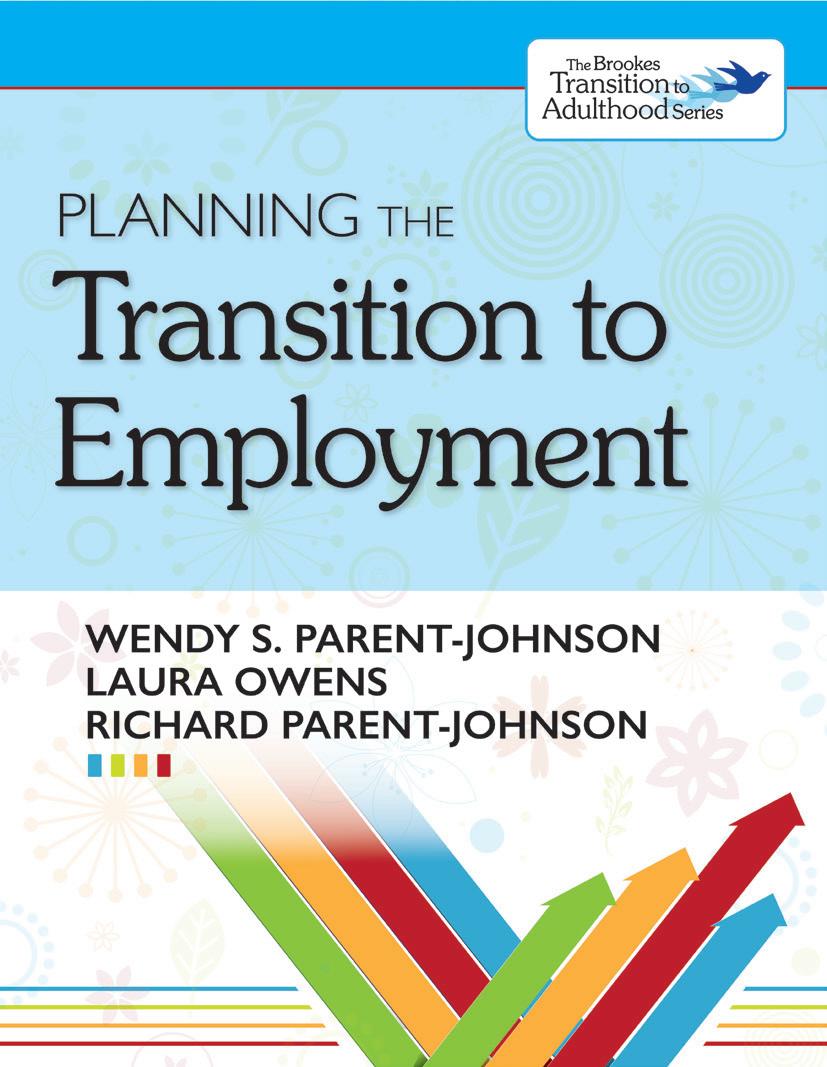
—Paul Wehman, Ph.D., Virginia Commonwealth University, Richmond
“Reflects optimism for employment outcomes for students with disabilities as well as the importance of student-centered approaches . . . full of practical strategies.”
—Richard Luecking, Ed.D., Center for Transition and Career Innovation, University of Maryland
With this practical text, you’ll prepare future professionals to get stu dents with disabilities ready for integrated, competitive employment in the real world. Developed by a team of respected experts, this book embraces the “Employment First” approach to career planning, which emphasizes integrated, competitive employment as the first and pre ferred option for all people, regardless of disability.
• Put together a “collective impact team” to support students’ transition to employment
• Apply four recommended practices to help students achieve good employment outcomes
• Implement a person-centered planning process that puts the stu dent in the driver’s seat
• Help students identify their passions, interests, and learning styles
• Support students in exploring careers using online tools and internship opportunities
• Facilitate successful collaboration with adult services agencies
• Work with local business community to connect students with potential employers
Provide students with the supports they need for success on the job
PRACTICAL MATERIALS: Case studies illustrate how to solve com mon obstacles to finding and keeping a job, and more than a dozen tools and forms—including the ITAP, the Job Observation Assessment Form, and a sample Employment Proposal—will help professionals in their future careers.
Getting Started
Strategies to Facilitate Effective Transitions
Planning for Employment: Person-Centered Planning and Adult Agency Involvement

4. Developing Skills, Identifying Passions, and Exploring Careers
5. Developing Employer Relationships to Create Job Opportunities

Providing Training and Supports While in School and After
Ways to Overcome the “Yeah, But…” Syndrome

Educational
 Edited by Fred P. Orelove, Ph.D. (Virginia Commonwealth University), Dick Sobsey, Ed.D. (University of Alberta), and Donna L. Gilles, Ed.D. (Virginia Commonwealth University)
Edited by Fred P. Orelove, Ph.D. (Virginia Commonwealth University), Dick Sobsey, Ed.D. (University of Alberta), and Donna L. Gilles, Ed.D. (Virginia Commonwealth University)
A cornerstone of special education training for nearly 30 years, this is the definitive textbook for preparing educators, counselors, and other related services professionals to teach children with severe and multiple disabilities in inclusive settings. Now in a revised, thoroughly updated, and streamlined fifth edition, this bestselling volume gives current and future educators the research and practical strategies they need to ensure the best learning outcomes for their students. Presenting a team-based, collaborative approach to education, this comprehensive text includes valuable contributions from respected experts in diverse fields, including fresh voices in special education, physical therapy, occupational therapy, communication, counseling, and pediatrics.
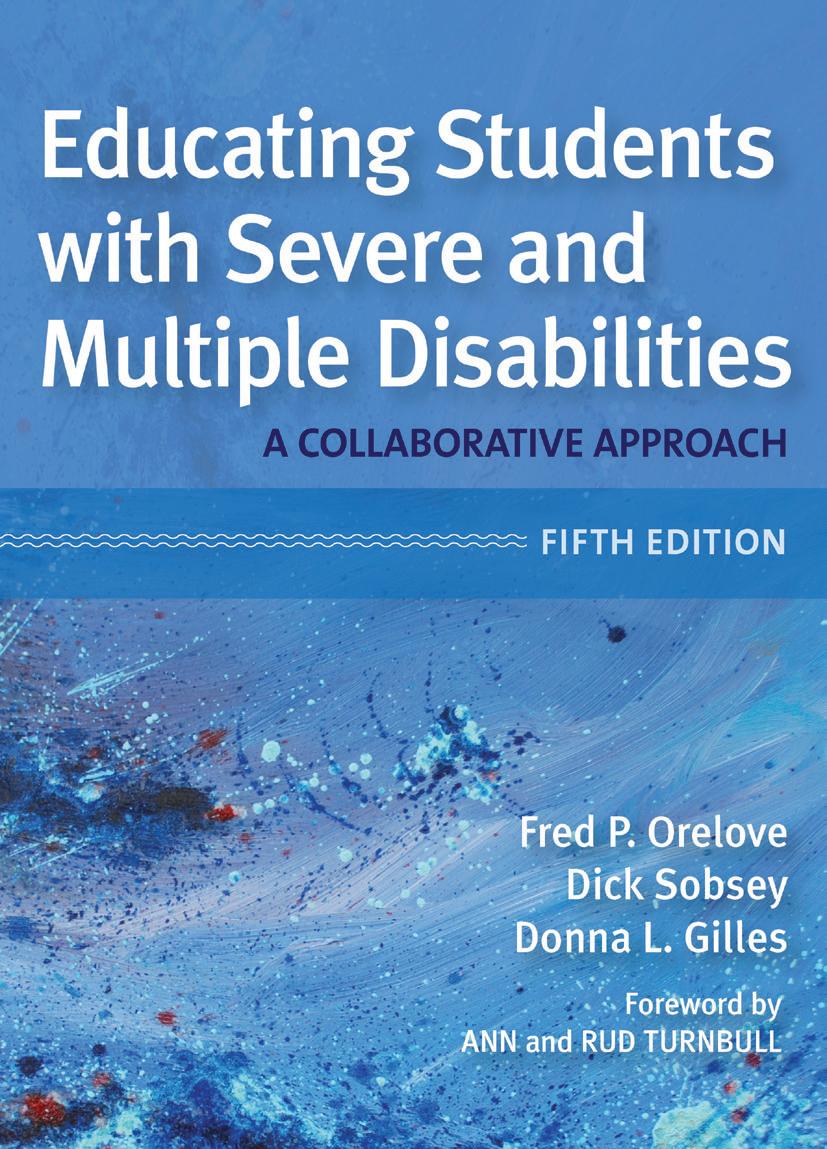
IN THIS EDITION:
• New chapters on topics essential to effective practice, such as teaching strategies and transition to adulthood
• Updates based on the latest developments in special education


Cutting-edge information on assistive technology and under standing challenging behaviors infused throughout the book
• New student-friendly features that enhance learning, such as chapter objectives, key terms, reflection questions, and challenging activities
• Engaging and instructive case stories at the start of each chapter
New online course materials, including slides that outline key ideas to remember
Helpful new chapter organization that introduces readers to the diverse needs of students with severe and multiple disabilities and follows up with practical teaching strategies
TOPICS COVERED: adaptations,
families
mealtime
physical disabilities
Literacy improves lives—and with the right instruction and supports, all students can learn to read and write. That’s the core belief behind this student-friendly textbook, an essential guide to providing comprehensive, high-quality literacy instruction to students with significant disabilities.
Drawing on decades of classroom experience, the authors present their own innovative model for teaching students with a wide range of significant disabilities to read and write print in grades preK–12 and beyond. Foundational teaching principles blend with concrete strategies, step-by-step guidance, and specific activities, making this textbook a complete blueprint for helping students acquire critical literacy skills they’ll use inside and outside the classroom.
An ideal text for courses that cover literacy and significant disabilities, this book will help future educators ensure that all students have the reading and writing skills they need to unlock new opportunities and reach their potential.

• Discover 10 success factors for helping students with significant disabilities become literate
• Prepare to teach emergent readers and writers skillfully, with evidence-based strategies for shared and independent reading, early writing instruction, and alphabetic and phonological aware ness
• Learn how to help students acquire conventional literacy skills, with adaptable strategies for teaching reading comprehension, vocabulary, writing, decoding, and spelling
• Get ready to organize and deliver comprehensive literacy instruc tion in a variety of settings, both inside and outside of school
• See how to use assistive technology effectively to support read ing, writing, and communication
• Learn tips on how to engage and motivate students and make literacy instruction meaningful to their everyday lives
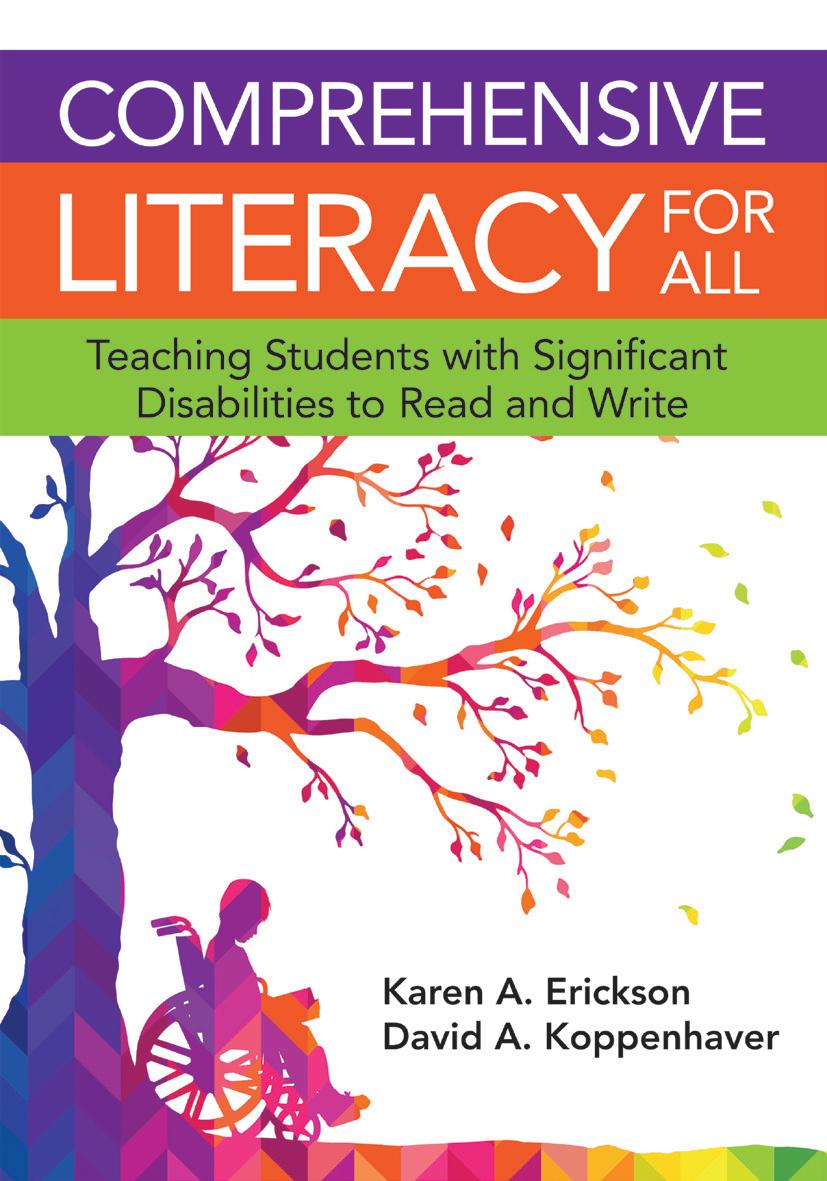
PRACTICAL MATERIALS: Sample teaching scenarios and dialogues, how-to strategies, and downloadable resources, including sample lessons, a quick-guide to key literacy terms, lesson sequences, and flowcharts to guide instruction.
1. All Children Can Learn to Read and Write: A Theoretical Rationale

Establishing the Environment for Successful Literacy Learning
BUILDING A FOUNDATION
Alphabet Knowledge and Phonological Awareness
Emergent Reading
Emergent Writing
III. LEARNING TO READ AND WRITE
Comprehensive Literacy Instruction: A ResearchBased Framework
Reading Comprehension and Vocabulary Instruction
Self-Directed Reading: Supporting Motivation and Fluency
Writing
Decoding, Word Identification, and Spelling
IV. IMPLEMENTATION
Using Assistive Technology Effectively to Support Literacy
Organizing and Delivering Effective Instruction

For new special educators, navigating the first few years on the job can be a complex challenge. Prepare your students for their future career with this positive and practical resource, a friendly guide to successfully applying knowledge from teacher prep programs to realworld classrooms.
Developed by two special education experts with decades of experience, this book gives future teachers a complete action plan for on-the-job success—from managing everyday details like paperwork and classroom routines to mastering big-picture strategies for behavior management, collaboration, and assessment. Potts and Howard speak directly to your students, talking them step by step through key procedures, addressing common questions and concerns, and giving them sound advice they can use for their whole career. Throughout the book, relatable quotes from new and seasoned educators offer real-world perspectives on the joys and challenges of teaching. An important supplemental textbook for the next generation of special educators!


Set up a classroom
Craft IEPs that reflect the student’s and family’s needs and goals
Plan differentiated lessons that address IEP goals
Find, use, and evaluate evidence-based practices

Choose or develop classroom assessments that are reliable and valid
Use positive strategies to reduce challenging behavior
Prepare themselves and their students for a classroom observation
professionalism in everything from attire to online
with other teachers, paraprofessionals,
MATERIALS:
students
each chapter, Planning Timeline
when; Special Topics boxes guide readers

to ethics, co-teaching, and English
boxes
what they learn.
activities and
The trusted core disability textbook gets a comprehensive update in this second edition, now thoroughly revised to include all the criti cal topics today’s professionals need to know about as they work with people who have disabilities. Brought to you by a new team of world-renowned experts and contributors, this volume fully prepares future educators, social workers, researchers, and clinicians to provide the best services and supports to children and adults across the life span. Tomorrow’s professionals will discover what to do and how to do it as they prepare for their important work, and they’ll refer to this user-friendly compendium year after year for information, insights, and answers. A cornerstone text for any course focused on developmental disabilities.

• Broad and deep, with thorough, up-to-date information on inter vention, education, family roles, health issues, specific disabilities, and much more
• Life-span-focused, with topics ranging from genetics and devel opment to aging issues
• Multidisciplinary, blending research and personal experiences of more than 70 esteemed authors from diverse fields
• Immediately applicable, presenting both the facts and practical, real-world advice on meeting the individual needs of people with disabilities
• Student-friendly, with learning objectives, instructive case stories, stimulating questions for reflection, and key Internet resources
I. INTELLECTUAL AND DEVELOPMENTAL DISABILITIES IN TODAY’S CONTEXT
II. HUMAN DEVELOPMENT
III. ETIOLOGY AND CONDITIONS
IV. SUPPORT AND INTERVENTION
V. INTELLECTUAL AND DEVELOPMENTAL DISABILI TIES THROUGH THE LIFE SPAN
VI. HEALTH

VII. THE FUTURE
IN THIS EDITION:
• New co-editors and contributors
SELECTED TOPICS COVERED: assessment and diagnosis

behavior and mental health
brain plasticity

cerebral palsy
• New and extensively updated chapters on critical topics, including AAC and technology, autism spectrum disorder, advocacy and self-advocacy, communi cation challenges, family issues, human development and genetics, legal and ethical considerations, and psychophar macology
and consent
direct support professionals
fetal alcohol spectrum disorder
developmental disabilities
education
fragile
syndrome
early development and intervention
employment
syndrome
POSITIVE BEHAVIOR SUPPORT
Three-tiered Model of School-wide Systems
Student Support
Core Features
Behavior
Behavior
and Responsive School
Unified Discipline
Development
Social and Emotional
Behavior
Facilitation
Students
Selected
Identified Students with Selected Inter ventions: Simple Functional Behavioral Assessment
and Implementing Selected Intervention
Evaluating, and Sustaining
INDIVIDUALIZED POSITIVE BEHAVIOR SUPPORT: CON DUCTING A FUNCTIONAL BEHAVIORAL ASSESSMENT

sessment
USING, AND EVALUATING
POSITIVE BEHAVIOR SUPPORTS
Individualized Positive Behavior
—Tim Knoster, Bloomsburg University
The revised and expanded edition of a popular book trusted in class rooms across the country, Behavior Support is your students’ guide to implementing effective positive behavior support (PBS)—both in the classroom and across an entire school. Future teachers will get explicit, strategies for implementing the three tiers of PBS: universal, school-wide interventions; selected interventions with students exhib iting risk behaviors; and specialized interventions with students who need intensive, individualized help. Packed with strategies, forms, and up-to-date research on multi-tiered systems of support, this practical text will help tomorrow’s teachers support positive changes in stu dents’ behavior.

• Stop challenging behavior before it starts

Improve communication, social, and self-control skills
Form positive, respectful relationships with classmates, teachers, and other community members
Take a more active part in their school, classroom, and community
More research and strategies on key topics, including bullying prevention, safe and responsive school climates, functional assess ment, and individual student interventions. You’ll also get more ex plicit step-by-step instructions, new case examples, tips on sustaining PBS, redesigned forms, and focusing questions for each chapter that

“A great resource for teachers and colleagues who are invested in effectively educating students with learn ing and behavior problems in inclusive settings.”
“A significant addition to the field’s research-based inclusive education resources. It provides practical strategies, . . . for school personnel and educators who want to make inclusive education a reality rather than just an ideal.”

—Martha Thurlow, Director of the National Center on Educational Outcomes
Your students will keep and use this quick, practical, ready-to-use guid ance on teaching all students—and making appropriate modifications for kids who need extra support. This third edition of the bestselling book in the Teachers’ Guides to Inclusive Practices series gives future teachers a clear and concrete plan for K-12 inclusion. Packed with field-tested strategies, case studies, and planning tools, this hands-on guide will show preservice teachers how to deliver effective universal instruction in core content areas and create customized adaptations and flexible supports for students with diverse needs and abilities. The next generation of teachers will learn what really works in inclusion, and they’ll discover how to seamlessly weave in modifications while encour aging each student’s sense of belonging.
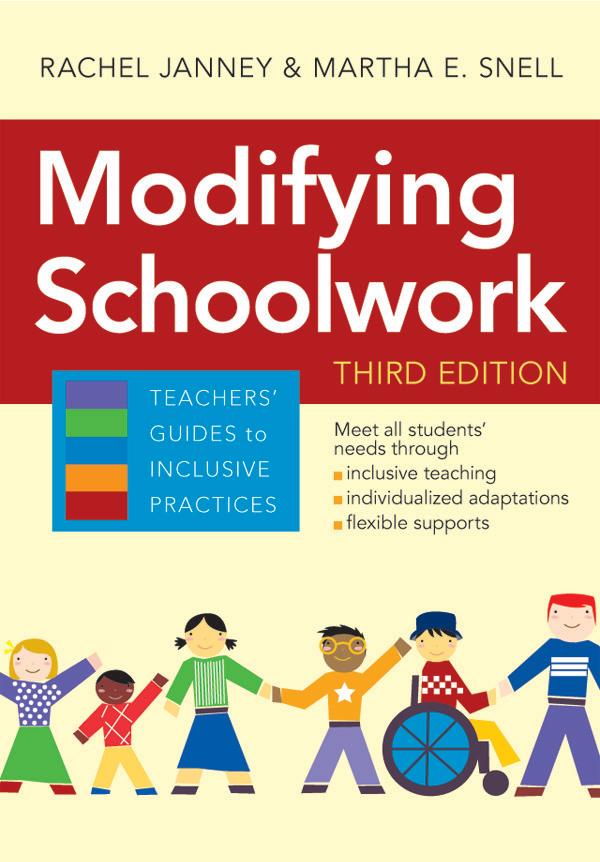
IN THIS EDITION:


• Practical guidance on implementing Universal Design for Learning
• Content aligns clearly with an RTI framework, with strategies span ning from whole-class instruction to highly individualized adaptations
• More on working with students with significant disabilities and com plex learning needs—one of the biggest challenges of inclusion
• Easy-to-print forms that help teachers plan individualized supports and adaptations, available at www.brookespublishing.com
• Helpful “focusing questions” at the start of each chapter—perfect for preservice study and teacher book club discussions
• New stories from teachers and parents that spotlight real-world challenges and successes
• Team Roles and Responsibilities Checklist
• Program-at-a-Glance
• Student Profile
• General Assessment of Classroom Activities
• Program Planning Matrix
• Individualized Adaptations and Support Plan
1. Inclusive Education: The Big Picture
2. Curricular and Instructional Practices that Promote the Inclusion and Success of All Students
3. A Model for Creating Individualized Adaptations and Supports
4. Planning, Implementing, and Evaluating Individualized Adaptations and Supports for Students with Extensive Needs
5. Including All Students in Instruction in Core Curriculum Areas
Appendix A: Blank Forms
Appendix B: Resources on Creating Effective Inclusive Schools and Designing Schoolwork for Inclusive Class rooms
THE FOUNDATIONS OF LITERACY AS A HUMAN RIGHT
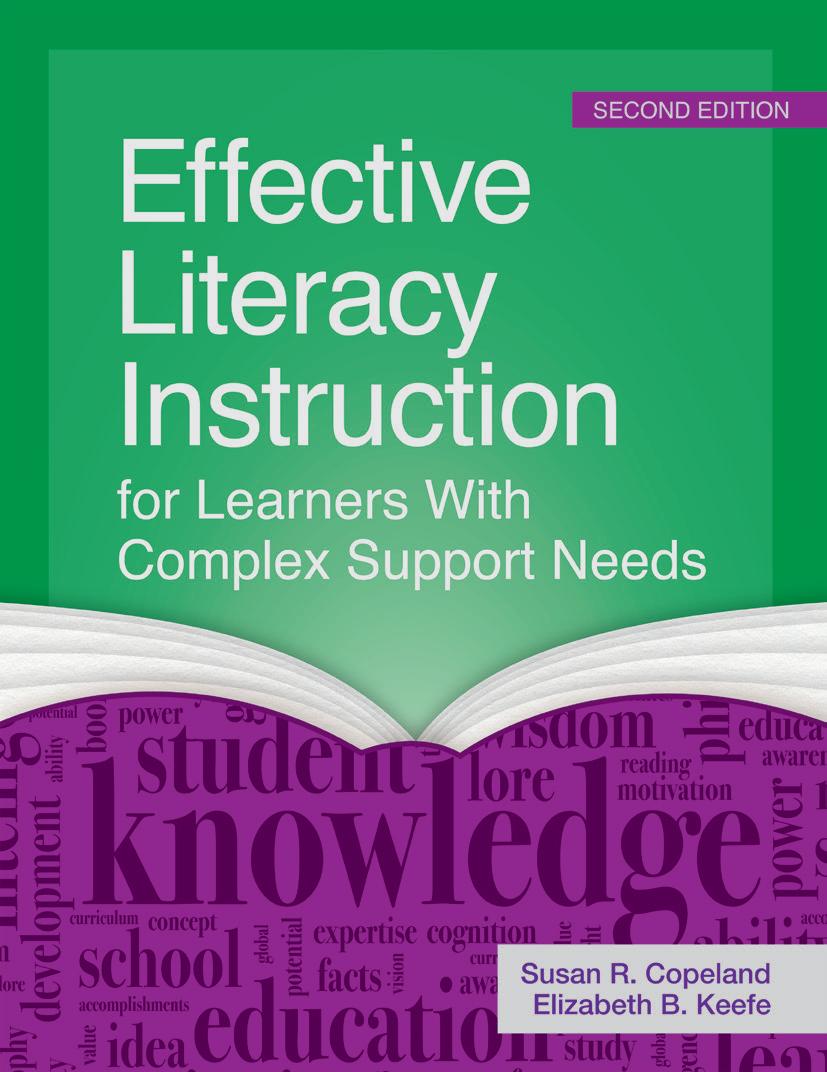
What are today’s best methods for teaching literacy skills to students with complex support needs—including autism, intellectual disability, and multiple disabilities? This comprehensive guidebook has up-todate, evidence-based answers for pre- and in-service educators.
Developed by Copeland and Keefe, the experts behind the landmark book Effective Literacy Instruction for Students with Moderate or Severe Disabilities, this thoroughly reimagined follow-up reflects 10 years of ground-breaking research and advances in the field. You’ll discover current recommended practices on critical topics, including how to build vocabulary, increase word recognition, enhance fluency, address cultural and linguistic diversity, and use academic standards when designing instruction. You’ll also get the guidance you need to put theory into practice: lesson planning strategies, practical examples, and case studies that bring key principles of instruction to life.
Whether used as a text for teachers in training or a guide for practicing educators, this book will help teachers of Grades K–12 increase access to literacy and prepare all learners for successful communication, employment, and community life.
THIS EDITION:
EVIDENCE-BASED COMPREHENSIVE LITERACY INSTRUCTION
New section on literacy as a human right for all learners (the “why” of instruction)

Chapters on how to design engaging learning environments

guidance on today’s assistive technology

CREATING OPPORTUNITY AND ACCESS TO LITERACY
books

“Snaps and crackles with ideas... and magically draws you into the profound belief that all students can become expert learners.”
—Dr. Ron B. Rogers, Director of the UDL Center at OCALI
Universal Design for Learning (UDL) is the best way to teach all students effectively and break down barriers to learning—but how can future teachers get started with UDL when they enter the classroom? The answers are in the second edition of this bestselling, teachertrusted primer, created by internationally recognized UDL expert Loui Lord Nelson.
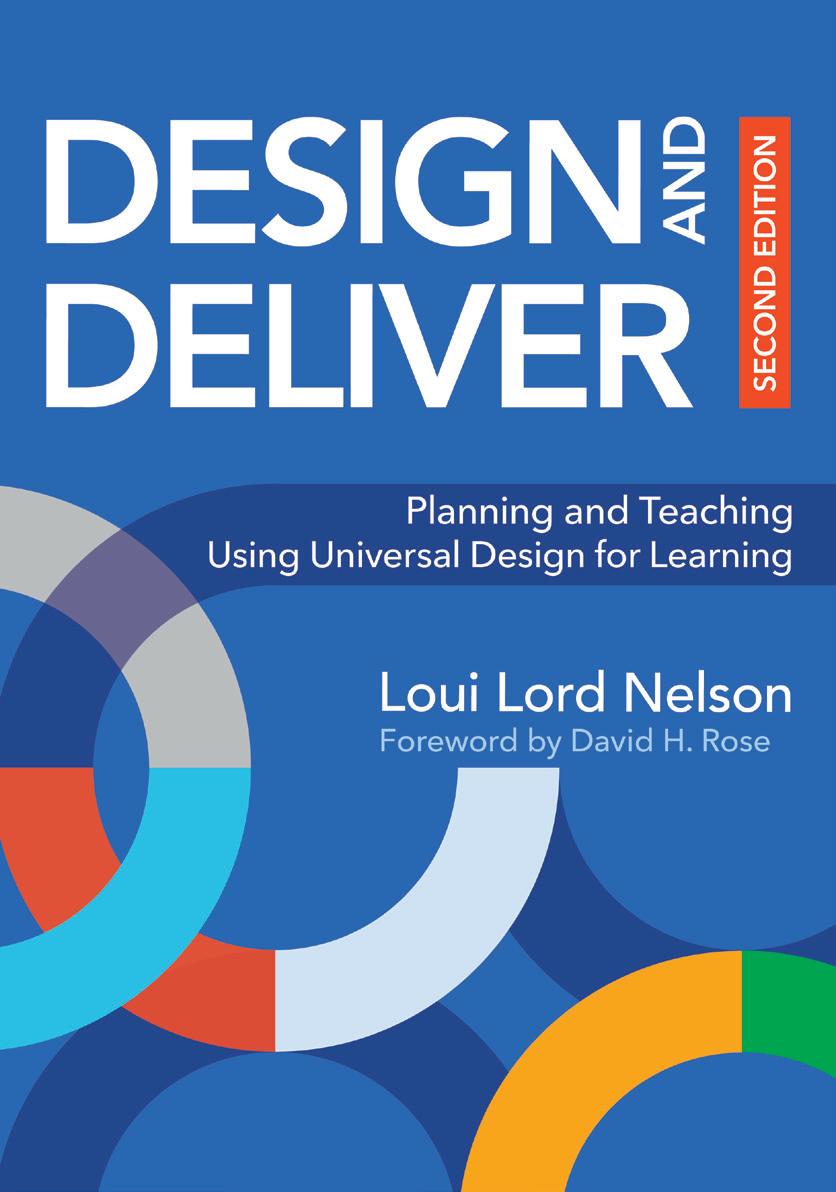
Thoroughly updated to reflect new research and developments in the field of UDL, this text gives tomorrow’s K–12 teachers a reader-friendly UDL introduction and a practical framework for implementation, with guidelines and checkpoints for designing effective, barrier-free lesson plans and learning environments. Your students will learn how to use the three core principles of UDL—Engagement, Representation, and Action & Expression—to present information in multiple ways and ensure access for all learners. Throughout the book, detailed examples, stories, illustrations, teacher reflections, and activities reinforce UDL principles and help teachers put them into practice in both virtual and in-person settings.
WHAT’S NEW:

• Key insights from the latest neuroscience research
• Useful stories and practical tips from teachers implementing UDL
• Technology bytes: timely tips and ideas on how to enhance online learning with UDL
• Expert guidance on current topics, including culturally responsive teaching, urban education, and a focus on the expert learner
• “Ponder this” prompts throughout the book to help readers consider new ideas and discover additional resources
• End-of-chapter “check-ins” that help readers apply what they’ve learned
ONLINE MATERIALS: Designing instruction with UDL is easier than ever with these online resources, available as printable downloads: CAST UDL Guidelines; an Identifying Your Resources chart; a UDL design cycle graphic; a UDL lesson plan flowchart; and classroom resource mapping charts for elementary, middle, and high school teachers.
I. INTRODUCING UNIVERSAL DESIGN FOR LEARNING

1. Introducing Universal Design for Learning
The Must-Knows of the UDL Framework
II. THE PRINCIPLES OF UNIVERSAL DESIGN FOR LEARNING
Engagement
Representation
Action and Expression
III. FROM PLANNING TO PRACTICE
The Learning Environment
The Goal and the Lesson
I. UNDERSTANDING TRAUMA
Trauma and Its Effects
The Role of Attachment in Development
Trauma’s Impact on Youth at School
BUILDING TRAUMA-SENSITIVE SCHOOLS
The Trauma-Sensitive School Framework

Paradigm Shifts
Essentials of Trauma-Sensitive Schools
IMPLEMENTING TRAUMA-SENSITIVE STRATEGIES
Universal Strategies for Trauma-Sensitive Schools
Supplemental and Intensive Trauma-Sensitive Interventions
The PACE Approach to Working With Traumatized Students
Trauma-Sensitive Discipline Practices
Self-Care for Educators
 By Jen Alexander, M.A., NCC, SB-RPT
By Jen Alexander, M.A., NCC, SB-RPT
“You need this book—even if you already have a full shelf. Packed with stories, wisdom, and practical tools, this is a resource you’ll come back to over and over again for ideas, support, and encouragement.”
In the United States, at least one in four youth experiences trauma severe enough to negatively affect their school success.* Get future educators ready to support students with this ideal supplemental textbook, a read er-friendly springboard for building responsive, trauma-sensitive preK–12 schools. Drawing on her experience as a school counselor, trainer, and mother, Jen Alexander delivers a comprehensive framework for build ing a supportive school environment that helps all students thrive. Your students will start with an evidence-based introduction to the impact of trauma on a child’s development, attachment, and behavior. Then they’ll get an effective multi-tier system of support (MTSS) for developing a trauma-sensitive learning environment, including both universal strategies (Tier 1) and more intensive interventions (Tier 2 and Tier 3) for students who need more support.
PREPARE EDUCATORS TO:
• Make five key shifts in the way they view and approach students, so that they’re better equipped to provide support
• Implement universal instructional strategies that foster safety, connection, regulation, and learning
Use special supports and coaching when universal strategies aren’t enough

• Collaborate effectively with families and colleagues to meet each student’s needs
Incorporate restorative discipline practices that focus on restitution, not retribution
Create a personalized self-care plan to reduce the effects of job-related stress
PRACTICAL MATERIALS: Creative activities for teachers, powerful case stories, sample dialogues and scripts, reflection and brainstorm ing worksheets, downloadable forms, a sample syllabus, and handouts for use in the classroom.

—Jody McVittie, Executive Director, Sound Discipline
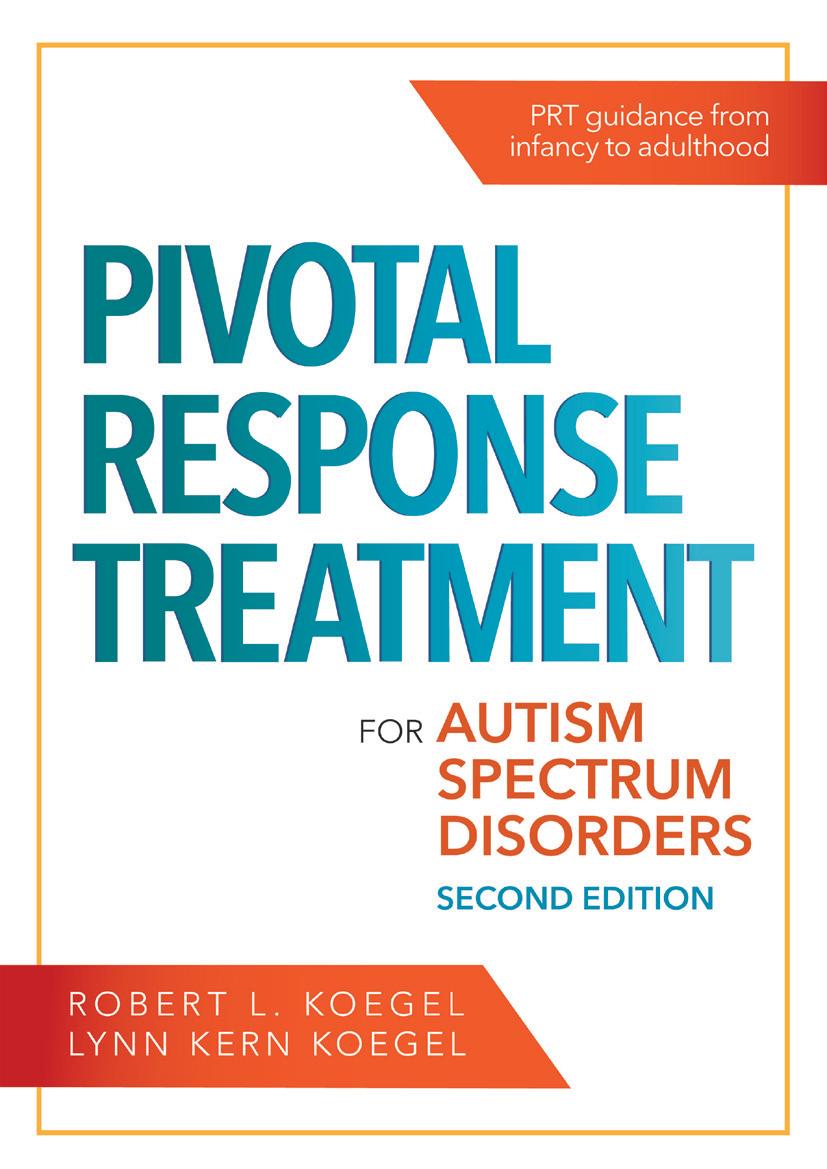
Edited by Robert L. Koegel, Ph.D. (Stanford University School of Medicine), & Lynn Kern Koegel, Ph.D. (Stanford University School of Medicine), with invited contributors
The pioneering experts behind Pivotal Response Treatment have created a comprehensive modern guide to this highly respected, research-based approach, completely reworked and revised for a new generation of therapists and educators. Strengthened with new research and more step-by-step guidance, this bestselling PRT text is now reorganized to support children on their whole developmental trajectory, from infancy through adulthood. New and revised chapters cover critical topics—including assessment and self-management— and the book’s down-to-earth, accessible style ensures that your students can grasp PRT principles and apply them effectively.
With this proven approach backed by more than 25 years of research, future professionals will be ready to support children with autism as they enjoy more positive interactions, more effective communication, and higher academic achievement.
• Advance children’s communication and language skills
• Aid early identification and intervention
• Improve children’s motivation and performance in school
• Foster friendships with peers during play dates and other social interactions
• Increase positive behavior by combining functional assessment and self-management strategies
• Decrease disruptive behavior

• Help young adults make a smooth transition to college, career, and community life
Each chapter features learning goals, key insights to remember, and helpful study questions (also available online to download and print).
New and completely reworked chapters on working with infants and toddlers, linking strengths-based assessment to treatment planning, improving adolescents’ communication and social skills, teaching par ents how to implement PRT, combining functional behavioral assess ment and self-management strategies, helping young adults succeed in college and the workplace.
I. OVERVIEW: PIVOTAL RESPONSE TREATMENT IN CONTEXT


The History and Basic Components of Pivotal Response Treatment
Assessment, Feedback, and Treatment Planning
Ecocultural Theory and Cultural Diversity
II. BEGINNING STAGES: EARLY INTERVENTION
Intervention for Infants and Young Toddlers
Teaching First Words
Expanding Friendship Opportunities for Children with ASD
III. CHILDHOOD: TREATMENT OPTIONS AT HOME AND AT SCHOOL
Parent Education in Pivotal Response Treatment
Inclusive Education
Motivational Academics
IV. ADOLESCENCE AND YOUNG ADULTHOOD: MOV ING TOWARD INDEPENDENCE
Functional Behavior Assessment and Self-Management
Improving Communication Skills in Adolescents and Adults with ASD
Improving Socialization in Adolescents and Adults with ASD
ADULTHOOD: HIGHER EDUCATION AND EMPLOYMENT
Improving Outcomes in Higher Education for Adults with ASD
Supporting Individuals with ASD in Employment Settings
FOUNDATIONAL TOPICS
Systematic
Measures
ADVANCED TOPICS

ALL TOGETHER
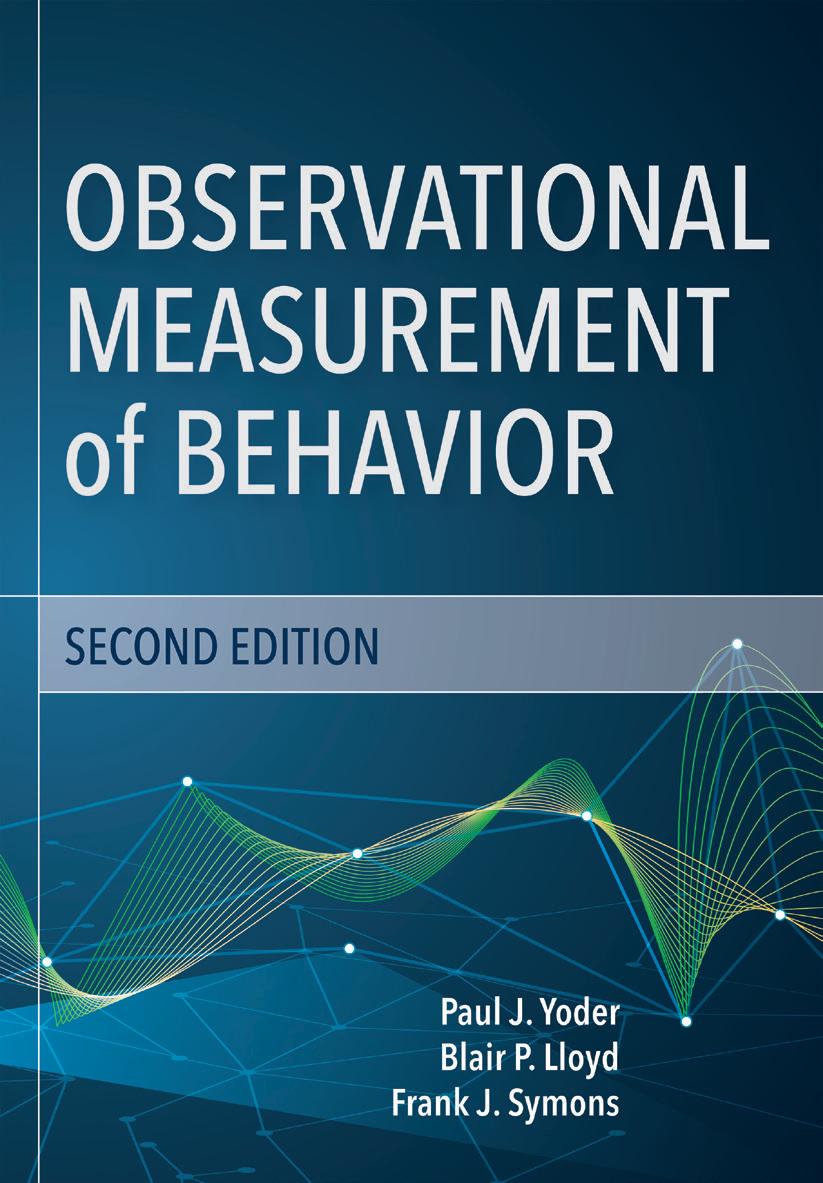
An essential textbook for anyone preparing to be a researcher, this comprehensive volume introduces graduate students to key prin ciples of observational measurement of behavior. Based on a course the highly respected authors taught at Vanderbilt University and the University of Minnesota, this text delves deeply into a highly effective approach to observational measurement: systematic observation.
Students will master both the theoretical principles of systematic observation and recommended research methods and techniques. They’ll learn from practical examples that illustrate complex concepts, clear explanations of recommended research methods, definitions of key terms, and exercises and assignments that help them practice putting principles into action. Online companion materials include two six-month licenses for proprietary observational software that students can use to complete the exercises and assignments in this book.
Ideal for use in research methodology courses in diverse fields—in cluding special education, communication sciences, psychology, and social work—this fundamental graduate text will prepare future researchers to skillfully collect, summarize, and communicate their observations of children’s behavior.

understand key methods of observational research and measurement

comprehensive information on both foundational and advanced topics
from real-world examples based on the authors’ experience
specific recommendations for effective techniques and best
ONLINE COMPANION MATERIALS:
enhance their courses,
package of online materials, including two
observational software, a media file students
practice coding behaviors, a suggested schedule for a
course, exercises for students, and assignments with
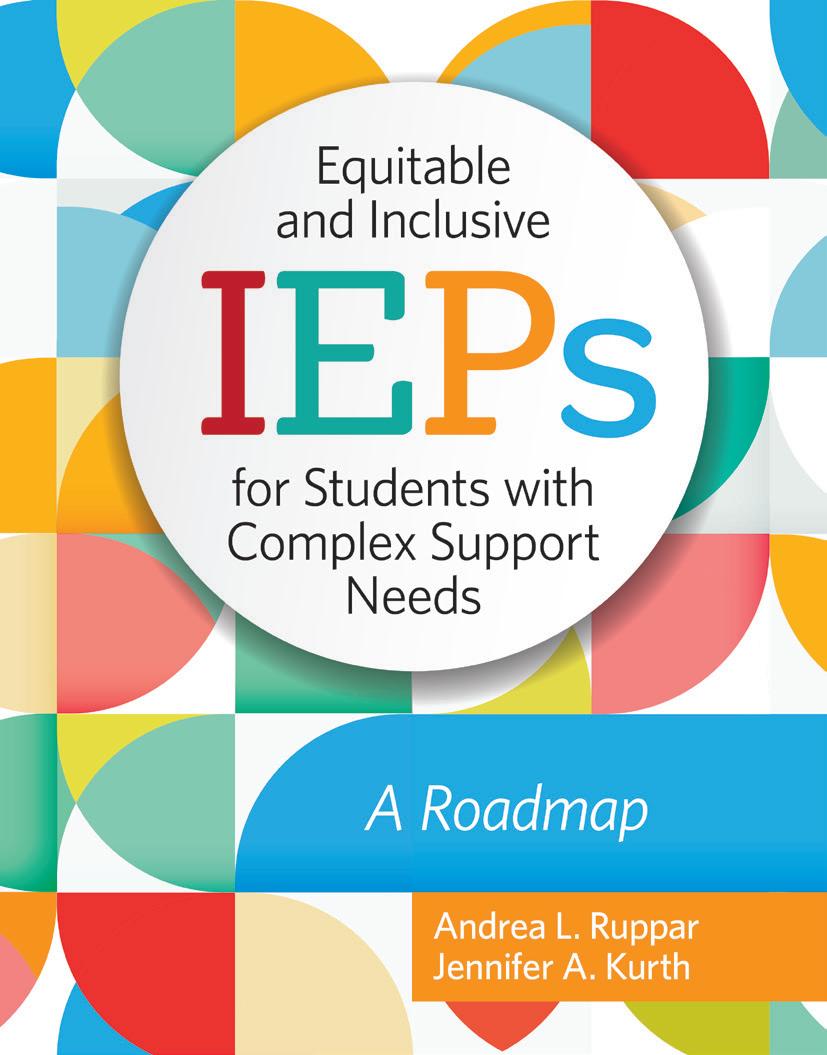
 By Andrea L. Ruppar, Ph.D. (University of Wisconsin–Madison), & Jennifer A. Kurth, Ph.D. (University of Kansas)
By Andrea L. Ruppar, Ph.D. (University of Wisconsin–Madison), & Jennifer A. Kurth, Ph.D. (University of Kansas)
Students who have the most significant support needs are at high risk for exclusion from general education. Prepare future educators to un lock access to inclusive education with this forward-thinking textbook, a step-by-step guide to person-centered, strengths-based, and meaning ful IEPs for K–12 students with complex support needs.
This practical text shows preservice educators how to develop complex IEPs—documents that include many academic, functional, and socialemotional goals; require assistive technology and communication sup ports; and involve services from a range of providers. Through chapters that correspond to the sections of the IEP document, future educa tors will master every step of creating a complex IEP, from planning to progress monitoring. Tips and strategies, vignettes and examples, and answers to critical questions help guide tomorrow’s teachers through the whole IEP process.
• Assemble an effective IEP team
• Gather information from the team and use it to make data-based educational decisions
• Collaborate with families during the IEP development process and beyond
• Describe a student’s Present Levels of Functional and Academic Performance (PLAAFP) in a comprehensive, strengths-based way
• Plan for alternate assessment and other special factors relevant to student learning
• Determine curriculum areas and individual skills for IEP goals
• Run a positive and productive IEP meeting
• Implement the IEP and monitor student progress
PRACTICAL MATERIALS: 15 downloads include forms and worksheets for teachers, surveys and communication tools to use with families, and a slide deck for planning the IEP meeting. Chapters begin and end with helpful activities that guide teachers to think about each IEP topic and take effective action.
US$49.95 | Stock #: 54630 | January 2023 | approx.
68125-463-0
I. BEFORE THE MEETING
1. Getting the Team Together
2. Organizing IEP Preparation and Communication


3. Fostering Collaborative and Trusting Relationships with Families and Students
4. Discussing Data and Making Decisions
II. DEVELOPING THE IEP
5. Describing Present Levels of Functional and Academic Performance
6. Planning for Special Factors, Extended School Year, and Alternate Assessment
7. Determining What Gets Taught: Curriculum and Goals
8. Identifying Supplementary Aids and Services
9. Determining the Least Restrictive Environment
III. AT THE MEETING AND AFTERWARD
10. Setting an Agenda and Setting the Tone: Com munication During the IEP Meeting
11. After the Meeting: Implementing the IEP
pages
The Brookes Download Hub is your home base for the online course materials— slides, test banks, sample syllabi, and more—that come with Brookes books. Sign up with your faculty email address to download companion materials, “favorite” your books to keep track of your online materials, and get free access to companion materials for ALL Brookes books. Registration is easy—sign up today! https://downloads.brookespublishing.com


You can request exam/desk copies of up to two books that are relevant to your course needs. If you see a book in this catalog that you’re interested in previewing, please look it up on www.brookespublishing.com, click the Request Exam Copy button found on the book’s page, and complete the request form. (All requested information must be supplied before we can process your order.)



